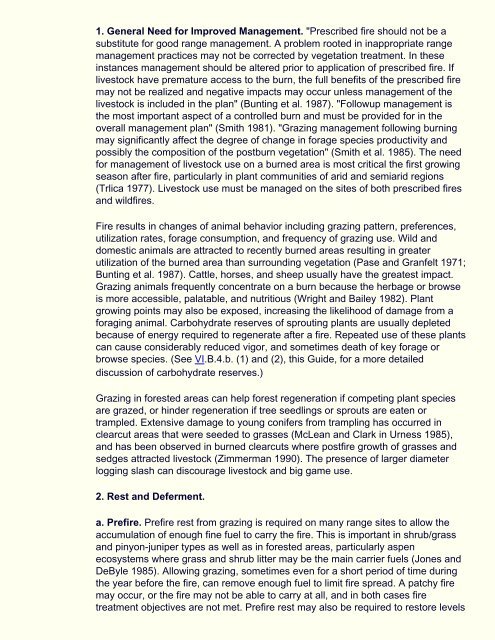FIRE EFFECTS GUIDE - National Wildfire Coordinating Group
FIRE EFFECTS GUIDE - National Wildfire Coordinating Group
FIRE EFFECTS GUIDE - National Wildfire Coordinating Group
Create successful ePaper yourself
Turn your PDF publications into a flip-book with our unique Google optimized e-Paper software.
1. General Need for Improved Management. "Prescribed fire should not be a<br />
substitute for good range management. A problem rooted in inappropriate range<br />
management practices may not be corrected by vegetation treatment. In these<br />
instances management should be altered prior to application of prescribed fire. If<br />
livestock have premature access to the burn, the full benefits of the prescribed fire<br />
may not be realized and negative impacts may occur unless management of the<br />
livestock is included in the plan" (Bunting et al. 1987). "Followup management is<br />
the most important aspect of a controlled burn and must be provided for in the<br />
overall management plan" (Smith 1981). "Grazing management following burning<br />
may significantly affect the degree of change in forage species productivity and<br />
possibly the composition of the postburn vegetation" (Smith et al. 1985). The need<br />
for management of livestock use on a burned area is most critical the first growing<br />
season after fire, particularly in plant communities of arid and semiarid regions<br />
(Trlica 1977). Livestock use must be managed on the sites of both prescribed fires<br />
and wildfires.<br />
Fire results in changes of animal behavior including grazing pattern, preferences,<br />
utilization rates, forage consumption, and frequency of grazing use. Wild and<br />
domestic animals are attracted to recently burned areas resulting in greater<br />
utilization of the burned area than surrounding vegetation (Pase and Granfelt 1971;<br />
Bunting et al. 1987). Cattle, horses, and sheep usually have the greatest impact.<br />
Grazing animals frequently concentrate on a burn because the herbage or browse<br />
is more accessible, palatable, and nutritious (Wright and Bailey 1982). Plant<br />
growing points may also be exposed, increasing the likelihood of damage from a<br />
foraging animal. Carbohydrate reserves of sprouting plants are usually depleted<br />
because of energy required to regenerate after a fire. Repeated use of these plants<br />
can cause considerably reduced vigor, and sometimes death of key forage or<br />
browse species. (See VI.B.4.b. (1) and (2), this Guide, for a more detailed<br />
discussion of carbohydrate reserves.)<br />
Grazing in forested areas can help forest regeneration if competing plant species<br />
are grazed, or hinder regeneration if tree seedlings or sprouts are eaten or<br />
trampled. Extensive damage to young conifers from trampling has occurred in<br />
clearcut areas that were seeded to grasses (McLean and Clark in Urness 1985),<br />
and has been observed in burned clearcuts where postfire growth of grasses and<br />
sedges attracted livestock (Zimmerman 1990). The presence of larger diameter<br />
logging slash can discourage livestock and big game use.<br />
2. Rest and Deferment.<br />
a. Prefire. Prefire rest from grazing is required on many range sites to allow the<br />
accumulation of enough fine fuel to carry the fire. This is important in shrub/grass<br />
and pinyon-juniper types as well as in forested areas, particularly aspen<br />
ecosystems where grass and shrub litter may be the main carrier fuels (Jones and<br />
DeByle 1985). Allowing grazing, sometimes even for a short period of time during<br />
the year before the fire, can remove enough fuel to limit fire spread. A patchy fire<br />
may occur, or the fire may not be able to carry at all, and in both cases fire<br />
treatment objectives are not met. Prefire rest may also be required to restore levels
















